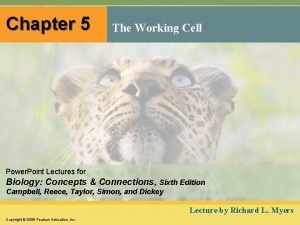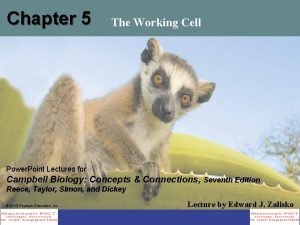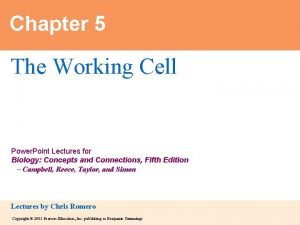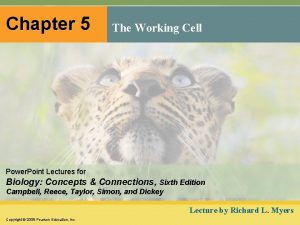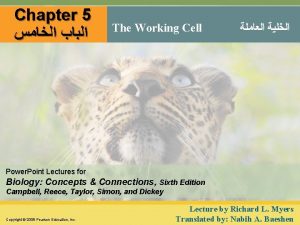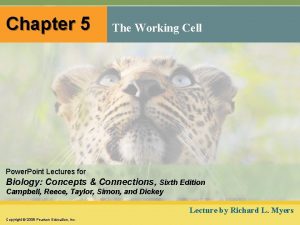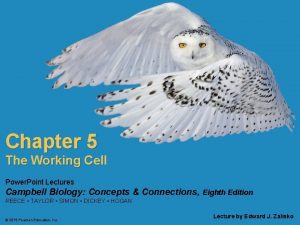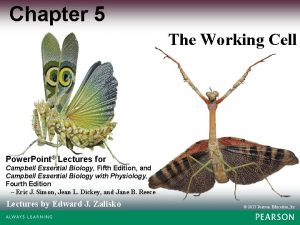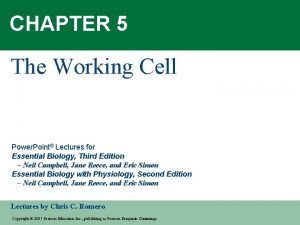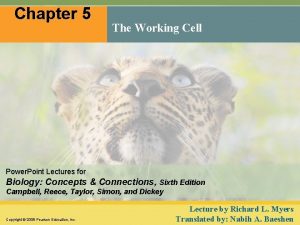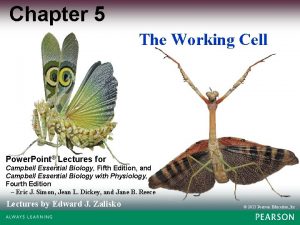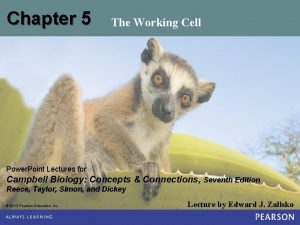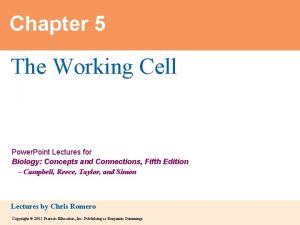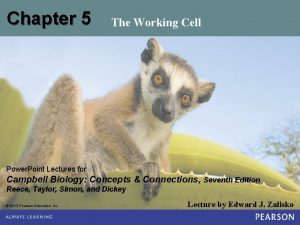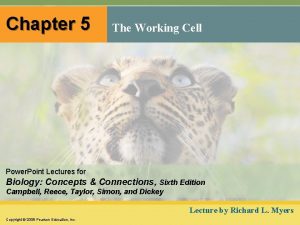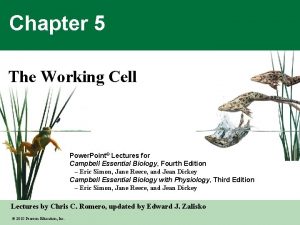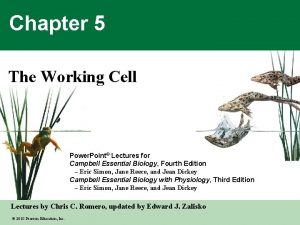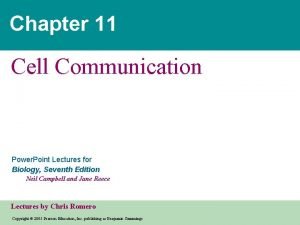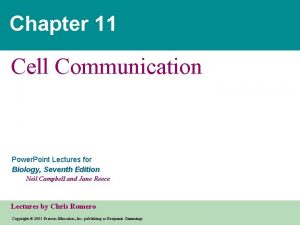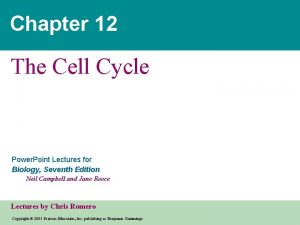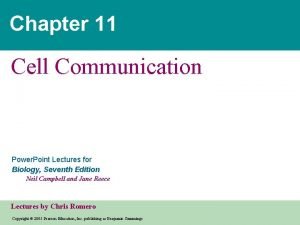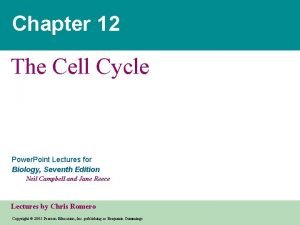Chapter 5 The Working Cell Power Point Lectures









































- Slides: 41

Chapter 5 The Working Cell Power. Point® Lectures created by Edward J. Zalisko for Campbell Essential Biology, Sixth Edition, and Campbell Essential Biology with Physiology, Fifth Edition – Eric J. Simon, Jean L. Dickey, Kelly A. Hogan, and Jane B. Reece © 2016 Pearson Education, Inc.

Chemical Energy • The molecules of food, gasoline, and other fuels have a form of potential energy called chemical energy, which arises from the arrangement of atoms and can be released by a chemical reaction. © 2016 Pearson Education, Inc.

Figure 5. 2 Fuel rich in chemical energy Energy conversion Waste products poor in chemical energy Heat energy Octane (from gasoline) + Oxygen Combustion Kinetic energy of movement Energy conversion in a car Carbon dioxide + Water Heat energy Cellular respiration Glucose (from food) + ATP Energy for cellular work Oxygen Energy conversion in a cell © 2016 Pearson Education, Inc. Carbon dioxide + Water

Food Calories • A calorie (cal) is the amount of energy that can raise the temperature of 1 gram (g) of water by 1°C. • Food Calories are kilocalories, equal to 1, 000 calories. • The energy of calories in food is used to fuel the activities of life. © 2016 Pearson Education, Inc.

Energy Transformations: ATP and Cellular Work • Chemical energy released by the breakdown of organic molecules during cellular respiration is used to generate molecules of ATP. • ATP • acts like an energy shuttle, • stores energy obtained from food, and • releases it later as needed. • Such energy transformations are essential for all life on Earth. © 2016 Pearson Education, Inc.

The Structure of ATP • ATP (adenosine triphosphate) • consists of an organic molecule called adenosine plus a tail of three phosphate groups and • is broken down to ADP, adenosine diphosphate, and a phosphate group, releasing energy. • The release of the phosphate at the tip of the triphosphate tail makes energy available to cells. © 2016 Pearson Education, Inc.

Figure 5. 4 Energy Triphosphate Adenosine P ATP © 2016 Pearson Education, Inc. P P Diphosphate Adenosine ADP P Phosphate (transferred to another molecule)

Figure 5. 5 -1 Motor protein ATP ADP P Protein moved (a) Motor protein performing mechanical work (moving a muscle fiber) © 2016 Pearson Education, Inc. P

Figure 5. 5 -2 Transport protein Solute P P ATP ADP Solute transported (b) Transport protein performing transport work (importing a solute) © 2016 Pearson Education, Inc. P

Figure 5. 5 -3 P ATP X Y ADP Y Reactants Product made (c) Chemical reactants performing chemical work (promoting a chemical reaction) © 2016 Pearson Education, Inc. P

The ATP Cycle • Cells spend ATP continuously. • Cellular work spends ATP, which is recycled when ADP and phosphate are combined, using energy released by cellular respiration. • Up to 10 million ATPs are consumed and recycled ATP muscle cell. each second in a working Cellular respiration: chemical energy harvested from molecules © fuel 2016 Pearson Education, Inc. Energy for cellular work ADP P

Enzymes • Metabolism is the total of all chemical reactions in an organism. • Most metabolic reactions require the assistance of enzymes, proteins that speed up chemical reactions without being consumed by the reaction. • All living cells contain thousands of different enzymes, each promoting a different chemical reaction. © 2016 Pearson Education, Inc.

Activation Energy • Activation energy is the energy that must be invested to start a reaction, by • activating the reactants and • triggering a chemical reaction. • Enzymes enable metabolism to occur by reducing the amount of activation energy required to break the bonds of reactant molecules. © 2016 Pearson Education, Inc.

Figure 5. 7 Activation energy barrier without enzyme Enzyme Reactant Energy Reactant Products (a) Without enzyme © 2016 Pearson Education, Inc. Activation energy barrier reduced by enzyme (b) With enzyme

Structure/Function: Enzyme Activity • After the products are released from the active site, the enzyme can accept another molecule of its substrate. • The ability to function repeatedly is a key characteristic of enzymes. • Many enzymes are named for their substrates, but with an –ase ending. © 2016 Pearson Education, Inc.

Figure 5. 9 -s 4 1 Ready for substrate Active site Substrate (lactose) 2 Substrate binding Enzyme (lactase) Galactose Glucose 4 Product release © 2016 Pearson Education, Inc. H 2 O 3 Catalysis

Enzyme Inhibitors • Certain molecules inhibit a metabolic reaction by • binding to an enzyme and • disrupting its function. • Some of these enzyme inhibitors are actually substrate imposters that plug up the active site. © 2016 Pearson Education, Inc.

Enzyme Inhibitors • Other inhibitors bind to the enzyme at a site remote from the active site, but the binding changes the enzyme’s shape so that the active site no longer accepts the substrate. • In each case, an inhibitor disrupts the function of an enzyme by altering its shape. © 2016 Pearson Education, Inc.

Figure 5. 10 Substrate (a) Enzyme and substrate binding normally Active site Enzyme Inhibitor (b) Enzyme inhibition by a substrate imposter Substrate Active site Enzyme (c) Inhibition of an enzyme by a molecule that causes the active site to change shape Active site Substrate Inhibitor Enzyme © 2016 Pearson Education, Inc.

Enzyme Inhibitors • In some cases, the binding of an inhibitor is reversible. • If a cell is producing more of a certain product than it needs, that product may reversibly inhibit an enzyme required for its production, keeping the cell from wasting resources that could be put to better use. © 2016 Pearson Education, Inc.

Enzyme Inhibitors • Many beneficial drugs work by inhibiting enzymes. • Penicillin blocks the active site of an enzyme that bacteria use in making cell walls. • Ibuprofen inhibits an enzyme involved in sending pain signals. • Many cancer drugs inhibit enzymes that promote cell division. • Many toxins and poisons also work as inhibitors. © 2016 Pearson Education, Inc.

Membrane Function • Cells must also regulate the flow of materials to and from the environment. • The plasma membrane consists of a double layer of fat (a phospholipid bilayer) with embedded proteins. • Figure 5. 11 describes the major functions of these membrane proteins. © 2016 Pearson Education, Inc.

Figure 5. 11 Cell signaling Enzymatic activity Cytoplasm Fibers of extracellular matrix Cytoskeleton Attachment to the cytoskeleton and extracellular matrix © 2016 Pearson Education, Inc. Transport Cytoplasm Intercellular Cell-cell joining recognition

Membrane Function • Of all the major functions of these membrane proteins, one of the most important is the regulation of transport in and out of the cell. © 2016 Pearson Education, Inc.

Passive Transport: Diffusion across Membranes • Molecules constantly vibrate and wander randomly. • Diffusion is the movement of molecules spreading out evenly into the available space. • Imagine a membrane separating pure water from a mixture of dye dissolved in water. © 2016 Pearson Education, Inc.

Figure 5. 12 Molecules of dye Net diffusion Membrane Net diffusion Equilibrium (a) Passive transport of one type of molecule Net diffusion Equilibrium (b) Passive transport of two types of molecules © 2016 Pearson Education, Inc.

Figure 5. 12 -1 Molecules of dye Net diffusion Membrane Net diffusion (a) Passive transport of one type of molecule © 2016 Pearson Education, Inc. Equilibrium

Passive Transport: Diffusion across Membranes • Passive transport is the diffusion of a substance across a membrane without the input of energy. • In passive transport, a substance diffuses down its concentration gradient from where the substance is more concentrated to where it is less concentrated. © 2016 Pearson Education, Inc.

Passive Transport: Diffusion across Membranes • Substances that do not cross membranes spontaneously, or otherwise cross very slowly, can be transported via proteins that act as corridors for specific molecules. • This assisted transport is called facilitated diffusion, a type of passive transport because it does not require the cell to expend energy. © 2016 Pearson Education, Inc.

Osmosis and Water Balance • The diffusion of water across a selectively permeable membrane is osmosis. • A solute is a substance that is dissolved in a liquid solvent, such as the salt in salt water, and the resulting mixture is called a solution. © 2016 Pearson Education, Inc.

Figure 5. 13 -s 2 Lower concentration (hypotonic) Sugar molecule (solute) Selectively permeable membrane © 2016 Pearson Education, Inc. Higher concentration (hypertonic) Osmosis (net movement of water) Equal concentrations (isotonic)

Osmosis and Water Balance • Compared to another solution, • a hypertonic solution has a higher concentration of solute, • a hypotonic solution has a lower concentration of solute, and • an isotonic solution has an equal concentration of solute. © 2016 Pearson Education, Inc.

Water Balance in Animal Cells • The survival of a cell depends on its ability to balance water uptake and loss. • For an animal to survive a hypotonic or hypertonic environment, the animal must have a way to balance the uptake and loss of water. • The control of water balance is called osmoregulation. © 2016 Pearson Education, Inc.

Figure 5. 14 Animal cell H 2 O Normal Plant cell H 2 O Lysing H 2 O Flaccid (wilts) (a) Isotonic solution © 2016 Pearson Education, Inc. H 2 O Turgid (normal) (b) Hypotonic solution Shriveled Plasma membrane H 2 O Shriveled (c) Hypertonic solution

Water Balance in Plant Cells • Plant cells have rigid cell walls. • Plant cells are healthiest in a hypotonic environment with a net inflow of water, which expands their cell walls without bursting. © 2016 Pearson Education, Inc.

Active Transport: The Pumping of Molecules across Membranes • Active transport requires that a cell expend energy to move molecules across a membrane. • Cellular energy (usually provided by ATP) is used to drive a transport protein that pumps a solute against the concentration gradient. • Active transport allows cells to maintain internal concentrations of small solutes that differ from environmental concentrations. © 2016 Pearson Education, Inc.

Animation: Active Transport © 2016 Pearson Education, Inc.

Figure 5. 16 -s 2 Lower solute concentration Solute ATP Higher solute concentration Active transport © 2016 Pearson Education, Inc.

Exocytosis and Endocytosis: Traffic of Large Molecules • Exocytosis is the movement of materials out of the cytoplasm of a cell via membranous vesicles or vacuoles that fuse with the plasma membrane. © 2016 Pearson Education, Inc.

Figure 5. 17 Outside of cell Plasma membrane Cytoplasm © 2016 Pearson Education, Inc. Molecule to be exported

Exocytosis and Endocytosis: Traffic of Large Molecules • In endocytosis, a cell takes material in via vesicles that bud inward. • For example, in a process called phagocytosis (“cellular eating”), a cell engulfs a particle and packages it within a food vacuole. © 2016 Pearson Education, Inc.
 Molecular biology lecture
Molecular biology lecture Power system lectures
Power system lectures Atp cycle
Atp cycle The real lesson 21
The real lesson 21 Informsu
Informsu Hard work and smart work
Hard work and smart work Hot principle
Hot principle Hot working and cold working difference
Hot working and cold working difference Differentiate between hot working and cold working
Differentiate between hot working and cold working Pembentukan logam
Pembentukan logam Point point power
Point point power The scientist mathias schleiden studied _______ in ______.
The scientist mathias schleiden studied _______ in ______. Rick trebino lectures
Rick trebino lectures Neonatology lectures
Neonatology lectures Data mining lectures
Data mining lectures Medicinal chemistry lectures
Medicinal chemistry lectures Uva orthopaedics
Uva orthopaedics Cs614 short lectures
Cs614 short lectures Activity identification approaches in spm
Activity identification approaches in spm Radio astronomy lectures
Radio astronomy lectures Dr sohail lectures
Dr sohail lectures Utilities and energy lecture
Utilities and energy lecture Web engineering lectures ppt
Web engineering lectures ppt Do words have power
Do words have power Frcr physics lectures
Frcr physics lectures Rotating anode
Rotating anode Introduction to recursion
Introduction to recursion Guyton physiology lectures
Guyton physiology lectures What is aerodynamics
What is aerodynamics Tamara berg husband
Tamara berg husband Theory and practice of translation lectures
Theory and practice of translation lectures Translation 1
Translation 1 Digital logic design lectures
Digital logic design lectures Kurose ross computer networking
Kurose ross computer networking Hegel three forms of art
Hegel three forms of art Nuclear medicine lectures
Nuclear medicine lectures Cs106b lectures
Cs106b lectures Cdeep lectures
Cdeep lectures Oral communication 3 lectures text
Oral communication 3 lectures text C programming and numerical analysis an introduction
C programming and numerical analysis an introduction Haematology lectures
Haematology lectures Bureau of lectures
Bureau of lectures


